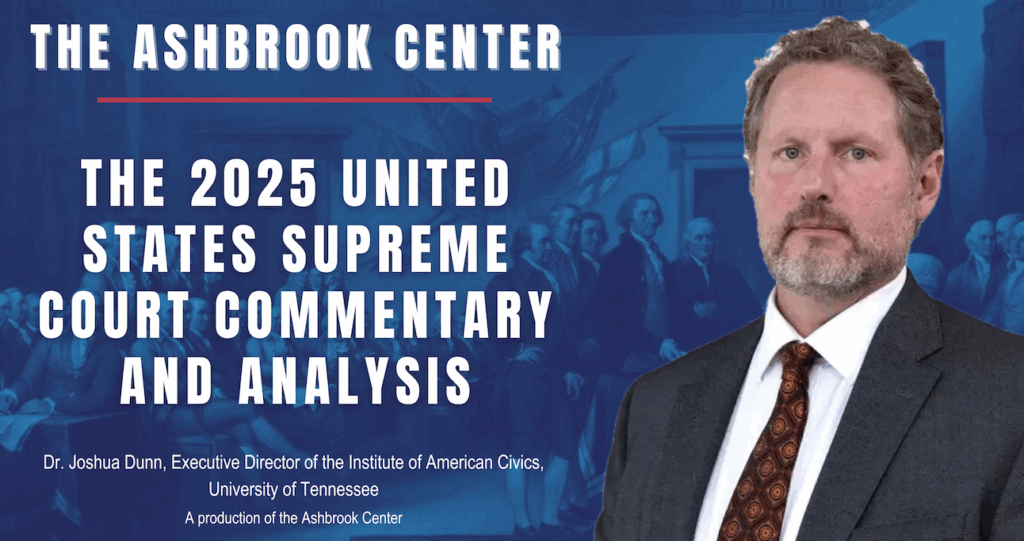2025 U.S. Supreme Court Decisions: Commentary and Analysis
July 9, 2025

Listen and subscribe to the podcast
Join The American Idea’s Listener Email list – get news about upcoming episodes and a chance to offer questions for them, too!
The Supreme Court’s 2025 term will be remembered as one of the most intriguing in recent memory, marked by surprising ideological coalitions and significant shifts in constitutional jurisprudence. The decisions handed down this term reveal a Court where traditional liberal-conservative divisions have given way to unexpected alliances on key constitutional principles.
A Term of Surprising Coalitions
Three cases define this term’s most striking characteristic: the emergence of liberal justices authoring majority opinions that conservatives would typically write. In Ames v. Ohio Department of Youth Services, Smith & Wesson Brands v. Estados Unidos Mexico, and Catholic Charities Bureau v. Wisconsin Labor and Industry Review Commission, Justices Jackson, Kagan, and Sotomayor respectively authored decisions that would have been unthinkable from liberal justices decades ago.
Justice Jackson’s unanimous opinion in Ames v. Ohio represents a particularly striking example. The decision ruled that Title VII of the Civil Rights Act doesn’t require higher evidentiary standards for discrimination claims from majority group members, overturning precedent from numerous lower courts. This ruling eliminates a barrier that had made it more difficult for members of majority groups to prove workplace discrimination.
Similarly, Justice Kagan’s majority opinion in the Smith & Wesson case sided with gun manufacturers against Mexico’s claims that they aided illegal gun trafficking. The Court found that Mexico could not plausibly allege that manufacturers had aided and abetted gun dealers’ unlawful sales of firearms to traffickers, representing a significant victory for Second Amendment advocates from an unexpected source.
The Evolution of Religious Freedom Jurisprudence
The Catholic Charities case, written by Justice Sotomayor, continued the Court’s expansion of religious freedom protections. The decision reinforced that religious organizations cannot be excluded from public programs simply because of their religious character. This ruling builds on a series of cases including the ministerial exception decisions and the Blaine amendment trilogy (Trinity Lutheran, Espinoza, and Carson), showing how religious liberty jurisprudence has evolved to provide broader protections for faith-based organizations.
The convergence of liberal and conservative justices on these religious freedom issues reflects the growing influence of originalist constitutional interpretation across the Court’s ideological spectrum. Even justices traditionally skeptical of broad religious exemptions have embraced principles that prioritize religious liberty alongside other fundamental rights.
Judicial Power and Nationwide Injunctions
Perhaps the most immediately impactful decision was Trump v. Casa, which addressed the controversial practice of nationwide injunctions. The Court significantly limited district court judges’ ability to issue sweeping injunctions that affect the entire country based on single cases. This practice had enabled extensive “forum shopping” by both conservative and liberal litigants, who would strategically file cases in jurisdictions where they expected favorable rulings.
The decision represents a major shift in how constitutional challenges will be litigated going forward. While district judges retain the power to issue injunctions for parties directly before them, they can no longer halt government policies nationwide based on their individual interpretation of the law. This change will likely require more comprehensive litigation strategies and may reduce the ability of single judges to shape national policy.
Parents’ Rights and Educational Authority
The term featured crucial developments in parents’ rights, particularly in Meyerson v. Taylor. This case involved a coalition of Muslim, Jewish, and Christian parents challenging Montgomery County, Maryland’s mandatory inclusive reading curriculum that required students to engage with materials on topics including transgenderism, pride parades, and same-sex marriage.
The Court’s decision builds on Pierce v. Society of Sisters, reinforcing that “the child is not a mere creature of the state” and expanding parental authority over their children’s education. The ruling establishes that parents’ fundamental rights extend beyond merely choosing between public and private schools to include meaningful input on curricular content that conflicts with their religious or moral beliefs.
The Administrative State Under Pressure
Continuing recent trends, the 2025 term saw further limitations on administrative agency power. The Court issued several decisions that curtailed the independence of federal agencies, reflecting ongoing tensions about the proper scope of executive power and congressional delegation of authority.
These decisions represent a historical irony: conservative justices are now leading the charge against independent agencies that were originally championed by liberal Democrats beginning with FDR’s New Deal. The Court’s skepticism toward administrative independence reflects broader concerns about the growth of federal bureaucracy and its impact on democratic accountability.
Looking Ahead
Future developments may include challenges to Oklahoma’s religious charter school policies, which could further expand the intersection of religious freedom and educational choice. The Court also faces ongoing questions about agency independence and the extent to which Congress can insulate federal officials from presidential removal.
Speculation continues about potential retirements, particularly whether Justice Thomas might serve long enough to become the longest-serving justice in Supreme Court history, which could significantly impact the Court’s composition and direction for decades to come.
A Court in Transition
The 2025 term demonstrates that constitutional interpretation continues to evolve, with justices across the ideological spectrum finding common ground on principles that transcend traditional partisan divides. While the Court maintains its basic ideological divisions, the influence of originalist methodology has created unexpected areas of consensus, particularly on issues involving religious freedom, parental rights, and the proper scope of judicial power.
Whether addressing religious freedom, parental rights, or the scope of federal power, this term’s decisions reveal a Court grappling with fundamental questions about the proper balance between individual liberty and governmental authority. The unexpected coalitions and shifting jurisprudence of the 2025 term suggest that the Supreme Court’s future decisions may be less predictable along traditional ideological lines than many observers expect.
For more analysis of American constitutional principles and their contemporary applications, subscribe to The American Idea and explore our complete archive of episodes featuring leading scholars and public intellectuals.

